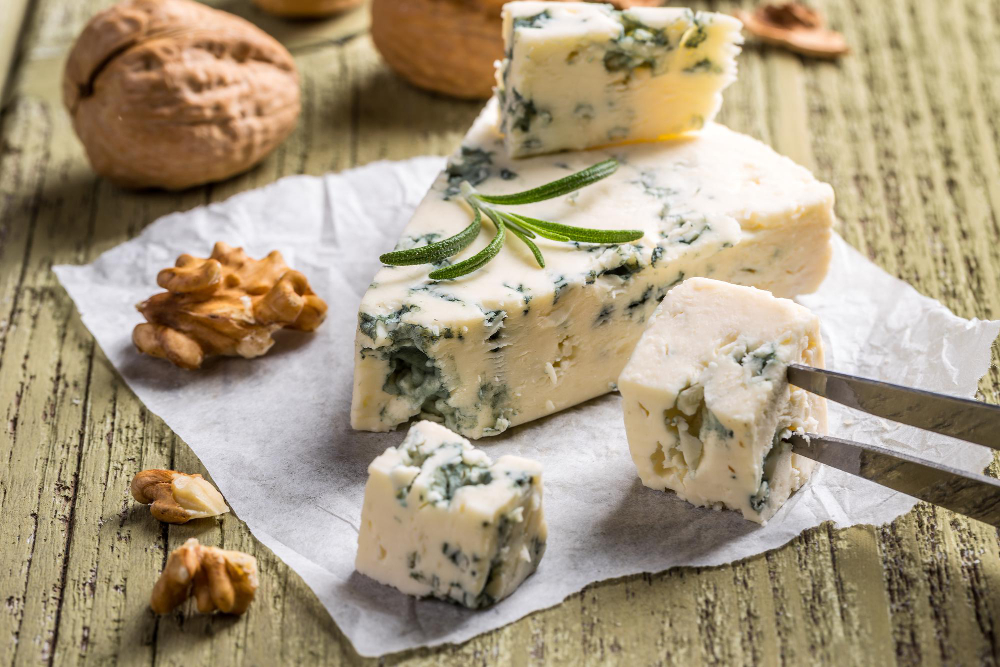The area of Gorgonzola is dominated by lush grasslands stretching across knitted rivers and lakes close to the Italian border. Gorgonzola cheese is named after the area steeped in Italian cuisine. This blue mold cheese, which resembles antique porcelain, oozes richness and flavor. It is soft and creamy when young, opening with agile butter strokes and gradually attaining a somewhat acidic finish. The mature versions are more potent, spicy, and have a pungent bite towards the end.
Cows graze on natural food in meadows throughout Lombardy and Piedmont, delivering unrestricted, full-bodied milk to creameries. The distinctive flavors of Gorgonzola are still linked to these locations, which were once supposed to stem from the exhaustion of herded cows.
Gorgonzola has a distinct look and can be utilized in various dishes, including risottos, pasta, and pizzas. The white and blue marbling on a cheeseboard looks elegant, and it goes well with grapes, honey, and pistachios.
Gorgonzola, sometimes called blue cheese, is made only from cow’s milk and has milder flavors than other blue cheeses. Its deep origins in Italian artisanship, which still influence current production, distinguish it from different blue cheeses.
It’s a classic combination of Gorgonzola cheese, mascarpone cheese, and walnuts.
How many foods can be paired with Gorgonzola? Fruit, vegetables, jams, honey, mustard, chocolate… The list goes on.
For every season, there’s a match: raw vegetables (radish, peppers, tomatoes, and celery) or fresh salads with a light dressing sauce.
It goes well with cooked vegetables (zucchini, broccoli, pumpkins, and potatoes). Spicy Gorgonzola cheese pairs well with fresh and dried fruit (strawberries, kiwis, apples, pears, and figs), especially marmalades and jams.
Is Blue Cheese or Gorgonzola Stronger?
Bleu cheese contains the mold Penicillium in the shape of spots or stripes. It is a blue cheese phenotype that’s created in Northern Italy. While both are commonly used in cooking, wine, and food, Gorgonzola has distinct flavors and appearances.
Blue cheese has a strong odor and is sharp and salty.
Typically, Gorgonzola cheese is crumbly and salty.
Bleu Cheese has a peculiar appearance due to the presence of a blue, blue-grey, or blue-green mold. Gorgonzola is a blue-green cheese with blue-green veins running through it.
Historians think the bleu cheese was discovered by chance, as the cheese was aged in caverns conducive to the growth of numerous molds. Roquefort, one of the most well-known varieties of blue cheese, was created around 1070 AD, while Stilton was developed in the 18th century.
Since 879 AD, Gorgonzola has been made in the Italian town of Gorgonzola. In the 11th century, the green-blue marbling effect was created. It is now produced in the Piedmont and Lombardy regions of northern Italy.
Is Gorgonzola Milder Than Blue Cheese?
Gorgonzola is milder than blue cheese, and it’s something that you should try on crackers or bread if you’d like to take it more slowly with other classes of blue cheese that may have a strong aroma or more complex flavor profiles.
The critical distinction between blue cheese and Gorgonzola is that Gorgonzola has a milder flavor and texture than other blue cheese variants. Therefore, Gorgonzola is a form of blue cheese. Blue cheese is an umbrella term that refers to cheese with blue mold veins. Furthermore, blue cheese is manufactured from cow, goat, or sheep’s milk, whereas Gorgonzola is made from cow’s milk.
Blue cheese variants are most commonly found in France and Italy, although they have spread worldwide.
Blue cheese provides a variety of flavors. Some of these cheeses are Gorgonzola, Danablue, Blue Stilton, and Roquefort.
The flavors and textures vary according to the variety, but they all have a salty, sharp taste and an aromatic scent. The presence of black, grey, green, and blue mold veins throughout the cheese is the most distinguishing trait of all. In addition, their rinds are tasty. Blue cheese is a rich source of proteins, phosphorous, and calcium. The downside, however, is its high sodium content.
Is Gorgonzola Similar to Goat Cheese?
Goat cheese is a creamy kind of cheese that goes well with many dishes. It can also be used as a substitute for Gorgonzola cheese. Simple goat cheese should suffice if you want the same level of richness that Gorgonzola cheese is known for. However, don’t expect it to be as powerful as Italian cheese.
Stilton is the most well-known of the English cheeses. It has a bluish hue, similar to Gorgonzola cheese. It is also available in a creamy white color. Unlike white Stilton, which has a mild flavor, blue Stilton has a robust flavor and taste. The flavor of young blue stilton cheese is slightly acidic. With time, the texture becomes softer and creamier. It can be substituted for Gorgonzola cheese in both hot and cold recipes.
Although Gorgonzola has a distinct flavor, the blue cheese isn’t tricky to substitute. If you don’t have any Gorgonzola cheese on hand, you don’t have to abandon the recipe. You can use any of the cheeses I suggested in its place.
What Is the Strongest Tasting Cheese?
If you’ve read anything about smelly cheese, you’re probably aware that Epoisse de Bourgogne, a French cheese from Burgundy, is frequently cited as the world’s stinkiest cheese. It’s so fragrant that it’s forbidden on French public transportation after being aged for six weeks in brine and brandy. Likewise, a German cheese, Limburger, is notorious for having a foot-like odor.
Epoisses de Bourgogne is made from whole cow’s milk created in the French commune of Époisses. The cheese, also known as Epoisses, has a creamy, chewy, and solid feel. It’s a smear-ripened cheese washed in marc de Bourgogne, with a unique soft red-orange color. It takes about six weeks for this cheese to ripen fully. Despite its pungent odor, the cheese has a spicy, sweet, and salty flavor. It pairs well with Trappist and Sauternes beers.

